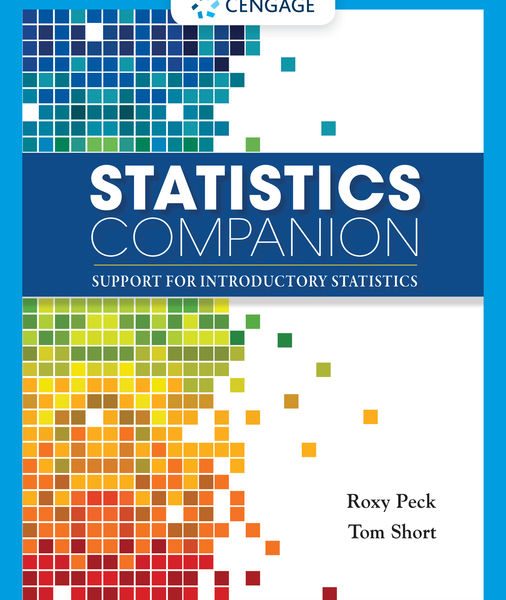Solution Manual for Statistics Companion: Support for Introductory Statistics, 1st Edition, Roxy Peck, Tom Short
Solution Manual for Statistics Companion: Support for Introductory Statistics, 1st Edition, Roxy Peck, Tom Short
$55.00
Description
Solution Manual for Statistics Companion: Support for Introductory Statistics, 1st Edition, Roxy Peck, Tom Short
Table of Contents
Preface
0. SMART STUDY STRATEGIES: The Learning and Memory Process. The Study Plan for Statistics. Productive Self-Concept through Mindfulness. Putting it all Together.
1. GETTING READY FOR STATISTICS: Numbers and the Number Line—A Quick Review. Rounding Decimal Numbers. Ordering Decimal Numbers. Getting to Know Your Calculator—Order of Operations, Powers of Numbers, Square Roots, and Scientific Notation.
2. CREATING GRAPHICAL DISPLAYS—THE MATH YOU NEED TO KNOW: Review—Rounding Decimal. Numbers, Plotting Points on the Number Line. Selecting an Appropriate Numerical Scale. Intervals and Interval Widths. Proportions, Decimal Numbers, and Percentages. Plotting Points in Two Dimensions. Evaluating Expressions.
3. MEASURES OF CENTER AND VARIABILITY—THE MATH YOU NEED TO KNOW: Review—Ordering Decimal Numbers, Square Roots, Distance Between Two Points. Variables and Algebraic Expressions. Summation Notation. Deviations from the Mean, Squared Deviations, Sum of Squared Deviations. Evaluating Expressions.
4. DESCRIBING BIVARIATE NUMERICAL DATA—THE MATH YOU NEED TO KNOW: Review—Variables, Scatterplots, Linear and Nonlinear Patterns, z-Scores. Working with Lines. Linear Models and Using a Line to Make Predictions. Deviations from a Line and the Sum of Squared Deviations. The Least Squares Line. Evaluating Expressions.
5. PROBABILITY—THE MATH YOU NEED TO KNOW: Review—Proportions, Decimal Numbers and Percentages, Ordering Decimal Numbers. Sets and Set Notation. Evaluating Expressions.
6. RANDOM VARIABLES AND PROBABILITY DISTRIBUTIONS—THE MATH YOU NEED TO KNOW: Review—Powers of Numbers, Square Roots, Intervals, Proportions, Decimals and Percentages, z-Scores. Random variables. More on Intervals. Equations and Inequalities. Areas Under a Curve. Areas of Rectangles and Areas of Triangles. Solving Simple Equations in One Variable. Working with Factorials (Optional, for those covering the Binomial Distribution). Evaluating Expressions.
7. HOW TO READ A STATISTICS PROBLEM: Chapter Overview. A Strategy for Reading a Statistics Problem. Guided Practice Reading Statistics Problems. On Your Own.
8. ESTIMATING A POPULATION PROPORTION—THE MATH YOU NEED TO KNOW: Evaluating Expressions. Guided Practice—Margin of Error. Guided Practice—Large Sample Confidence Interval for a Population Proportion. Guided Practice—Determining Sample Size.
9. TESTING HYPOTHESES ABOUT A POPULATION PROPORTION—THE MATH YOU NEED TO KNOW: Evaluating Expressions. Guided Practice—Large Sample Hypothesis Test for a Population Proportion.
10. ESTIMATING A DIFFERENCE IN PROPORTIONS—THE MATH YOU NEED TO KNOW: Evaluating Expressions. Guided Practice—Estimating a Difference in Proportions.
11. TESTING HYPOTHESES ABOUT A DIFFERENCE IN PROPORTIONS—THE MATH YOU NEED TO KNOW: Evaluating Expressions. Guided Practice—Testing Hypotheses About a Difference in Proportions.
12. ESTIMATING A POPULATION MEAN—THE MATH YOU NEED TO KNOW: Evaluating Expressions. Guided Practice—Estimating a Population Mean.
13. TESTING HYPOTHESES ABOUT A POPULATION MEAN—THE MATH YOU NEED TO KNOW: Evaluating Expressions. Guided Practice—Testing Hypotheses About a Population Mean.
14. ESTIMATING A DIFFERENCE IN MEANS WITH PAIRED SAMPLES—THE MATH YOU NEED TO KNOW: Evaluating Expressions. Guided Practice— Estimating a Difference in Means with Paired Samples.
15. TESTING HYPOTHESES ABOUT A DIFFERENCE IN MEANS WITH PAIRED SAMPLES—THE MATH YOU NEED TO KNOW: Evaluating Expressions. Guided Practice— Testing Hypotheses About a Difference in Means with Paired Samples.
16. ESTIMATING DIFFERENCE IN MEANS WITH INDEPENDENT SAMPLES—THE MATH YOU NEED TO KNOW: Evaluating Expressions. Guided Practice— Estimating Difference in Means with Independent Samples.
17. TESTING HYPOTHESES ABOUT A DIFFERENCE IN MEANS WITH INDEPENDENT SAMPLES—THE MATH YOU NEED TO KNOW: Evaluating Expressions. Guided Practice—Testing Hypotheses About a Difference in Means with Independent Samples.
18. CHI-SQUARED TESTS—THE MATH YOU NEED TO KNOW: Evaluating Expressions. Guided Practice— Chi-Squared Tests.
19. ESTIMATING AND TESTING HYPOTHESES ABOUT THE SLOPE OF A POPULATION REGRESSION LINE—THE MATH YOU NEED TO KNOW: Evaluating Expressions. Guided Practice—Confidence Interval for the Slope of a Population Regression Line. Guided Practice—Testing Hypotheses about the Slope of a Population Regression Line.
20. TESTING HYPOTHESES ABOUT MORE THAN TWO MEANS—THE MATH YOU NEED TO KNOW:
Evaluating Expressions. Guided Practice—One-Way Analysis of Variance.



Reviews
There are no reviews yet.